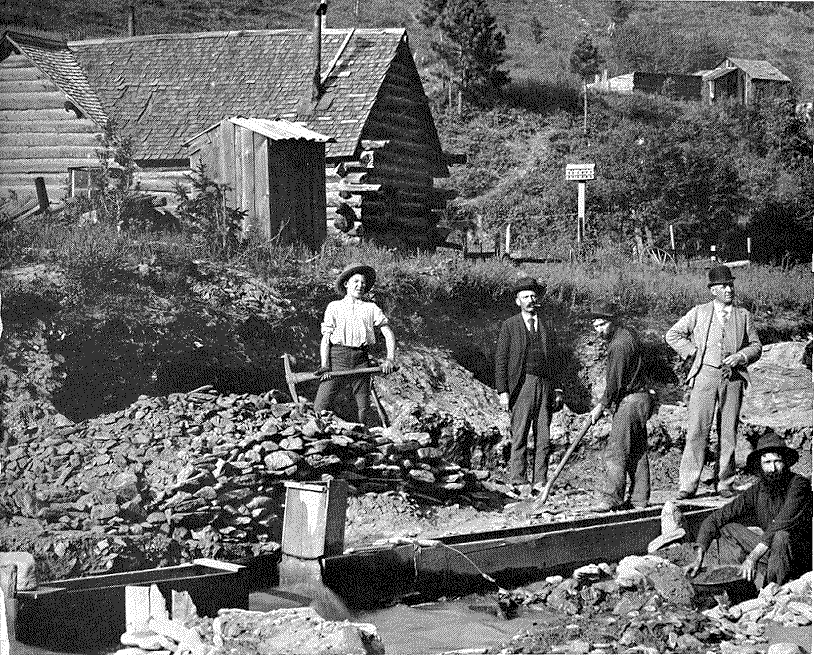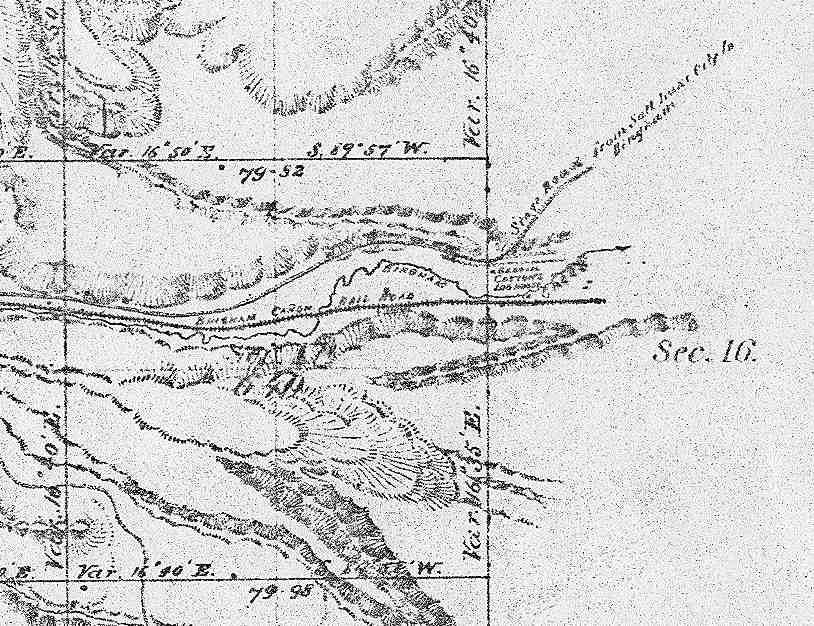This picture appeared in Utah Historical Quarterly, Summer 1963, Vol. 31 No. 3, p.193
In the early 1870s the Cotton family were neighbors to the Butchers, living about 1/2 mile to the west from their ranch. The above picture was at first believed to portray placer miners at Bingham, but a caption has been discovered at the LDS Church Historical Archives that identifies the scene as being "#557, Washing out gold, Black Hills of South Dakota". It was taken by early Utah photographer C.W. Carter. A copy of this photograph was examined at the LDS Church Archives. The text written on the logs on the side of the cabin facing the photographer reads
" CHOOSE THE BEST PLACE TO BUY GOODS
WHEN IN WANT OF ANYTHING CHAS
ALL KINDS OF JEWELRY MADE TO ORDER MORSE "
The "Best Place" reference led historian Leonard Arrington to believe that the photograph may have been made in the vicinity of Bingham Canyon, which is near Salt Lake City, where Brigham Young pronounced "This is the right place." However, this no longer seems to be the case. But it's a nice picture, so it stays.
The scene is very similar to the situation at the Cotton home in lower Bingham Canyon, and Mr. Carter did not have to go to South Dakota to take the picture. There is no known picture of the Cotton family or their home, but it probably was similar to the one shown. If anyone has or has seen a better picture, please contact me.
The Cotton family didn't just drop out of nowhere. Gabriel Sr. was a son of Caleb and Nancy Meredith Cotton, early converts to the Latter-day Saints Church. According to Cotton family historian Ross Cotton, Caleb and Nancy married in Raleigh, North Carolina on 16 Nov 1801. Their son Gabriel was born 28 Jan 1822 in Vienna, Johnson County, Illinois. It is said that Gabriel's parents were Cherokee Indians, and in fact among the first Indians to join the church. Gabriel Sr. had a sister, Peninah, who married Daniel Wood and was one of the early settlers of Woods Cross, between Bountiful and Salt Lake City. If you know much about Mormon history you are no doubt familiar with Wilford Cotton Wood, one of her descendants who as a wealthy fur grower in the 1920s was the first to take an interest in collecting and preserving LDS historical artifacts and sites. He published two books, Joseph Smith Begins His Work, Vol. 1 and 2, which was the first time early LDS books were reprinted. He built a private museum to display his collections, which exists at Woods Cross to this day.
Gabriel Sr. received his patriarchal blessing (#168) from the Prophet's brother, William Smith, on August 22, 1845. When the Mormons established the settlement of Genoa, Nebraska as a supply center for handcart pioneers, Gabriel and his family lived there, but caused considerable problems for the Mormons, as described in the journal of Joel Hills Johnson. Although he eventually came to Utah, he continued to associate with bad company such that today he might be considered somewhere between "less active" and "apostate." Before coming to Bingham the Cottons lived for a time at Wanship in the mountains east of Salt Lake City. They appear to have moved from Wanship sometime after Caleb was born there in 1864, no doubt because of the excitement of mining discoveries that also attracted the Butchers.
Gabriel Cotton, Sr. was married to Mary Jane King. In the summer of 1873 he was 50 years old, she was 47. Their children included Gilbert, 21; Gabriel, Jr., 19; Nancy, 17; Mary, 14; Melinda, 11; Caleb, 9. It is not certain whether all of these children were living at home in 1873, but we do know Gilbert, Gabriel Jr. and Caleb were. Marla Webb has discovered that Nancy was married to Ben Tasker. There may also have been older children: William, 31; Lucy, 29; and Jane, 25. There are conflicting sources of information between the International Genealogical Index, the Ancestral File, and other records of the LDS Church Genealogical Society, as well as US Census records, so more work remains to be done.
The exact location of the Cotton's log home ("Gabriel Cotton's Log House") can be pinpointed on the following map, as located by Utah's Surveyor General J. Fewson Smith in May of 1873. Its location is described in the surveyor's notes in chains and links, which can be translated to more familiar measurements: the northwest corner of Gabriel Cottons cabin is 3886 feet north of the southwest corner of Section 16, and 16 1/2 feet east of the west edge of Section 16. The present Bingham Cemetery is directly north of the site. The Butcher family lived 1/4 mile east of the Cottons, and the Mumfords lived 1/4 mile east of Butchers.


